Types of Headphone Jacks & Plugs – Simplified and Explained
by Scarlett Martin
Audio cables are not the most exciting subject, but they are essential to any home theater system. If you want to enjoy your movies or music with crisp sounds, you must have the right cables connecting all your devices. This blog post will help you understand each type of connector and choose the perfect one for your needs.
If you wonder what audio connectors to use, you should look at the following chart first. It includes all of the most common cables and plugs used with consumer electronics and explains how they work.
This is not an exhaustive list, but it covers 99% of devices on the market today, making it perfect for choosing your following audio cables.
Contents
- Difference Between a Headphone Jack and Headphone Plug
- More on Headphone Plugs
- Different Sizes of headphone plugs
- 5mm Plug (most commonly known as the ⅛ inch plug)
- 4mm Plug
- 5mm Plug (aka 1/8-inch connector)
- 5mm Plug (3/22-inch Connector)
- XLR Connector (aka 3-Pin, 4-Pin, or 5-Pin XLR Connector)
- RCA Connector (aka Phono)
- S/PDIF Connector (aka TOSLINK)
- Spade Lug Connector (aka Spades)
- Banana Plug Connector (aka Banana Jacks)
- SpeakON Connector
- Analog & Digital Audio Connectors
- Balanced vs. Unbalanced Audio Signals
- Conclusion
- Related Posts
Difference Between a Headphone Jack and Headphone Plug
In many cases, people mix up a headphone jack and a headphone plug. These terms are not interchangeable because they refer to two completely different things that serve entirely different purposes, just like gaming headsets and headphones.
AND, NO! WE ARE NOT TALKING ABOUT JACK AND THE BEANSTALK.
Jokes aside, here is a picture showing the difference between Audio Jacks and Plugs.

A headphone jack is an audio connector that you can find on your computer or mobile device. It allows you to either send sound from the source into headphones or receive it from them when connected in reverse order (the cable's tip goes to the output). Essentially this type of connection functions as both input and output ports rolled into one point for convenience. However, its design makes it more prone to damage over time due to poor strain reliefs since there are only those thin rubber bands holding everything together next to fragile components like solder joints.
Male & Female Connectors

In most cases, you will see these connectors marked with the small icon pointing downwards. The tip is always on the right side, and it has two parts: an inner metal sleeve that goes into your device's port and an outer plastic part that protects against abrasions and other types of damage from outside elements. This design makes them very durable and relatively bulky by today's standards, which is why they are no longer used in consumer products for cost-cutting reasons (you can find one example, though - HDMI connector).
Male audio plugs have three or four pins inside to transfer sound signals, while female sockets contain only holes without anything inside where male ends go through, so there would be no shorting issues if something conductive gets stuck there. You may hear a static noise if any of those connectors are damaged.
More on Headphone Plugs
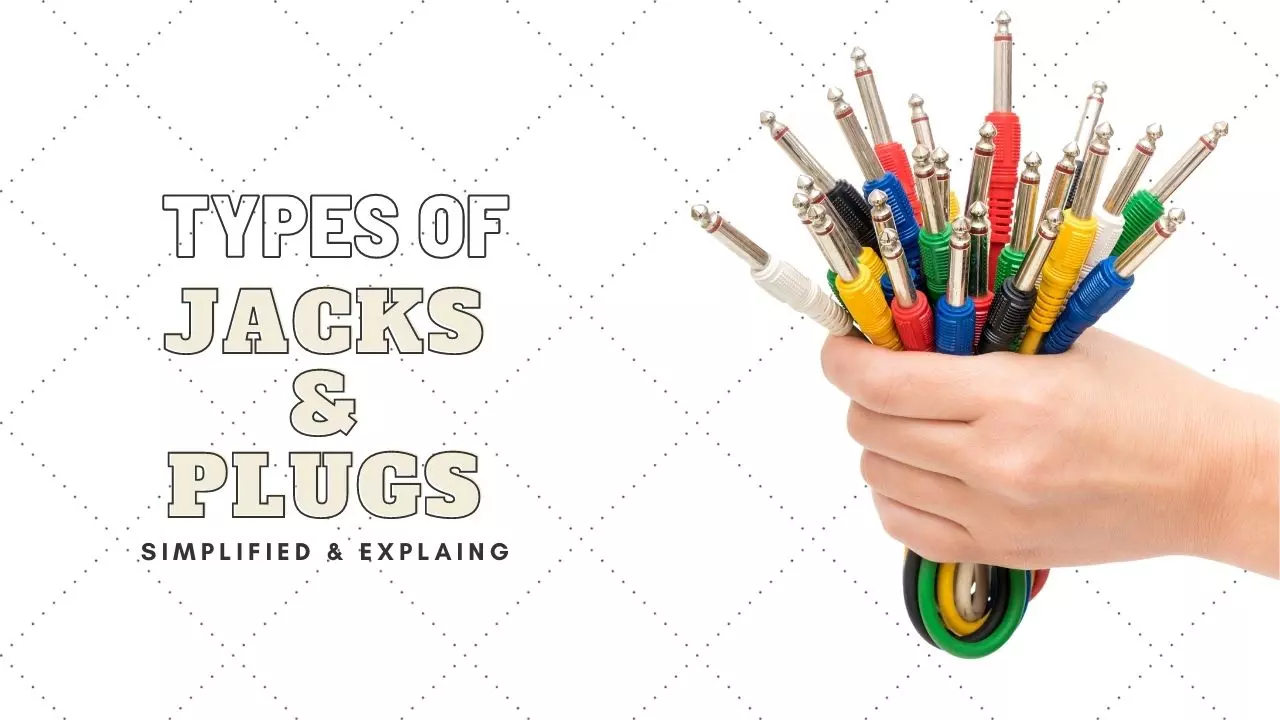
The most critical component of a headphone plug is the tip, which comes into contact with your headphones. The tip typically has a metal conductor to transfer sound from one device to another and might have some material coating it for improved audio quality. Some common materials used in headphone plugs are copper, gold, or silver for better conductivity, while others opt for rhodium, palladium, or nickel plating.
The next part of the headphone plug that you should know about is called "the barrel," which provides insulation between the tip and rest of the connector to ensure an uninterrupted signal when it makes contact with your headphones. It also helps to hold everything together in one cohesive unit. The barrel might be made out of plastic, rubber, or metal.
The last part of the headphone plug is called "the shoulder," Its purpose is to hold everything together in one cohesive unit. It usually rests just underneath the collar that you see on most plugs and provides support for all components inside its structure. The quality of headphone plugs or jacks can improve the sound volume of your headphones.
Conductors Found On A Headphone Plug
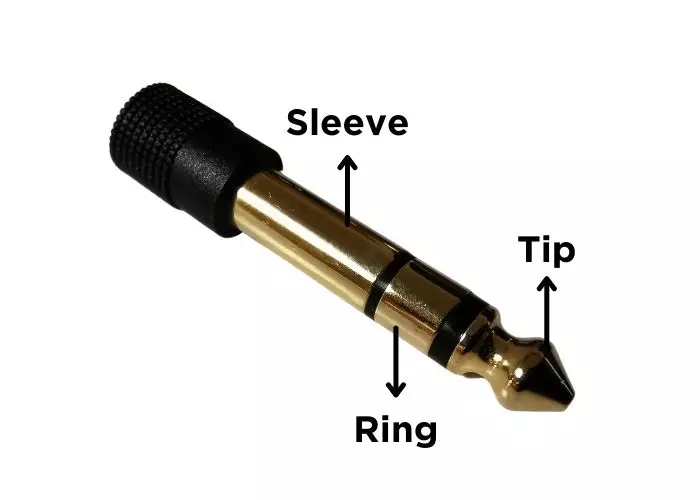
There are three types of conductors on headphone plugs.
- Tip (T)
- Ring (R)
- Sleeve (S)
The Tip (T) of a headphone plug handles the left side audio channel. The Ring (R) covers the right-side audio channel. At the same time, the Sleeve (S) covers the ground connection on a headphone plug.
The number of rings on a headphone plug can vary. There are commonly two rings on a headphone plug to handle both the left and proper audio channels. However, a three-ring design can sometimes be found in higher-end devices to allow enhanced noise cancellation when using an inline microphone with your headphones.
The number of conductors inside each ring varies depending upon whether you have one, two, or three rings. The most common configuration for a headphone jack is to have one ring with a Tip (T), Ring (R), and Sleeve (S), all in one cohesive unit.
A typical three-ring configuration for a TRRS is T, R, and S. A four-conductor plug has an extra ring that provides the fourth conductor as a ground connection on the sleeve of the headphone jack.
- 2 conductor, 2 poles, TS
- 3 conductor, 3 poles, TRS
- 4 conductor, 4 poles, TRRS
- 5 Conductor, 5 poles TRRRS
2 Conductor Plug (TS)
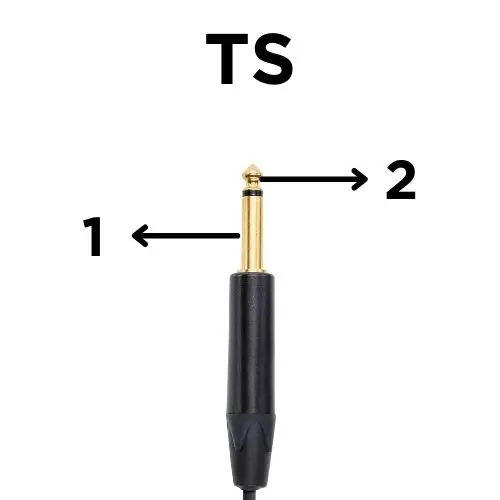
| Pin | Purpose |
|---|---|
| 1 | Ground |
| 2 | Signal |
This is a two-conductor version that does not have an extra ring. Therefore, it can be used for headphones or microphones with single dynamic element type transducers. This configuration only has the Tip (T) and Sleeve (S). The other side of this Plug will go to the ground, which you should avoid using if possible, or it will connect directly to microphone input on your device without any additional rings designed for audio signals.
Common Usage: Guitars, Low-End Microphones, Musical Instruments.
3 Conductor Plug (TRS)
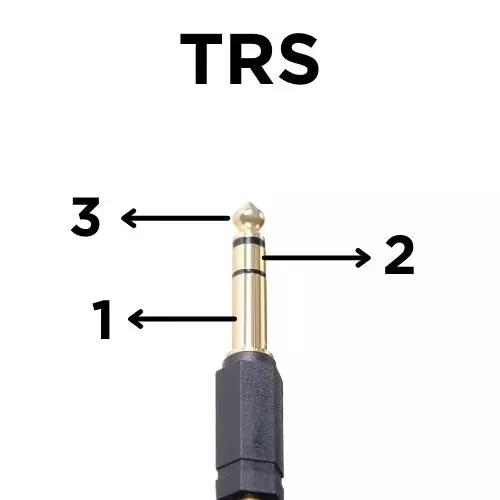
| Pin | Unbalanced Mono | Unbalanced Stereo | Balanced Mono |
|---|---|---|---|
| 1 | Ground | Ground | Ground |
| 2 | Mic & Others | Right Audio Channel | Cold Signal (-) |
| 3 | Signal | Left Audio Channel | Hot Signal (+) |
This is a three-conductor version that has one ring with Tip (T), Ring (R), and Sleeve (S). The other side will either go to the ground or connect directly to microphone input on your device without any additional rings designed for audio signals.
The other Ring (R) allows it to transfer Balanced Mono, Unbalanced Mono, and Unbalanced Stereo signals from the source audio device, and vice versa.
Common Usage: Low-end Headphones, Microphones, Audio/Video Devices.
4 Conductor Plug (TRRS)

| Pin | Purpose |
|---|---|
| 1 | Microphone |
| 2 | Ground |
| 3 | Right Audio Channel |
| 4 | Left Audio Channel |
This is a four-conductor version that has two rings with Tip (T), Ring (R), and Sleeve (S). The other side will either go to the ground or connect directly to microphone input on your device without any additional rings designed for audio signals.
Common Usage: Headsets/Headphones with Microphone Support, Gaming Consoles, and modern Smartphones/ PCs.
5 Conductor Plug (TRRRS)
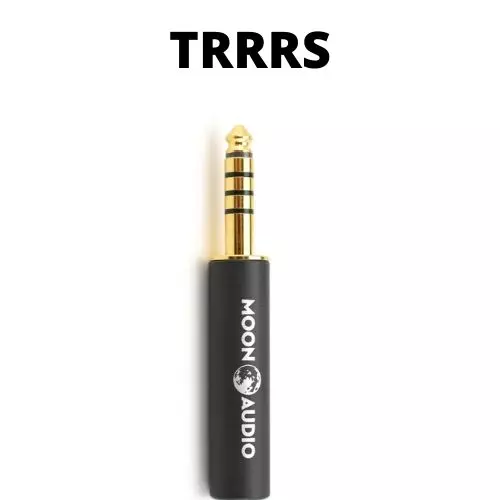
This is a five-conductor version that has three rings with Tip (T), Ring (R), and Sleeve (S). The other side will either go to the ground or connect directly to microphone input on your device without any additional rings designed for audio signals.
The TRRS connector is also known as the XLR connector, used chiefly for balanced stereo signals. Moreover, the XLR connector has pins instead of tips, rings, and sleeves.
Common Usage: Professional Audio Equipment, Home Recording Studio.
Different Sizes of headphone plugs
The headphone or audio jacks are further divided into different sizes. These jacks are sized as diameters.
6.5mm Plug (most commonly known as the ⅛ inch plug)

This is a fairly standard size used on most personal audio devices. This has become an industry-standard headphone connector since its introduction in the second half of the 20th century. The first device to use this was some transistor radio, which you can still find at antique stores today.
Common Usage: Personal Audio Devices (iPod/MPlayer), Mobile Phones, Laptops, Cameras.
¼ inch Plug (aka Quarter-inch phone jack or Phone Jack)
The quarter-inch phone plug is another common-sized headphone jack that also fits into smaller form factor devices such as laptops and mobile phones with dedicated music players designed for them. It offers better sound
4.4mm Plug
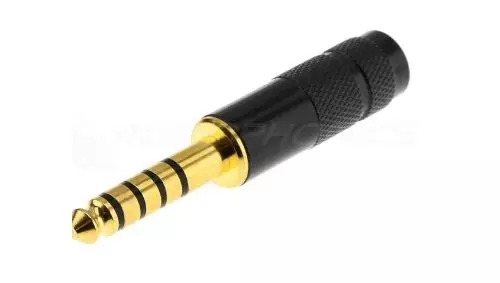
Sony makes the 4.4mm Audio plug. This headphone plug is also known as a 4.4mm Pentaconn Connector. However, this Pentaconn connector is a new technology, and it is not commonly used in any new audio devices.
The 4.4mm Audio Plug is a TRRRS jack. It has three Rings (R), one Tip (T), and one Sleeve (S).
Common Usage: Not widely adopted.
3.5mm Plug (aka 1/8-inch connector)
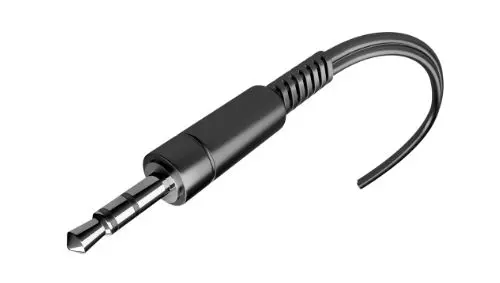
This type of connector is the most commonly used in many mobile phones and personal audio players. It's a miniaturized version of the ¼ inch headphone jack with three bands instead of four to avoid interference on stereo headphones' right and left channels.
Common Usage: Portable Media Players (iPod/MPlayer), Laptops, Mobile Phones, Tablets, Headphones, Microphones.
2.5mm Plug (3/22-inch Connector)
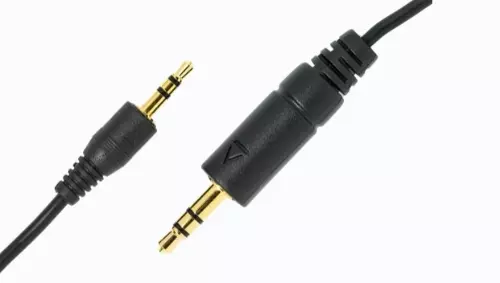
This type of connector is used in one way audio-signal transfer technology like video cameras. However, it is sometimes used in walky-talkies. In addition, this type of audio Plug is not commonly used in professional audio equipment.
XLR Connector (aka 3-Pin, 4-Pin, or 5-Pin XLR Connector)
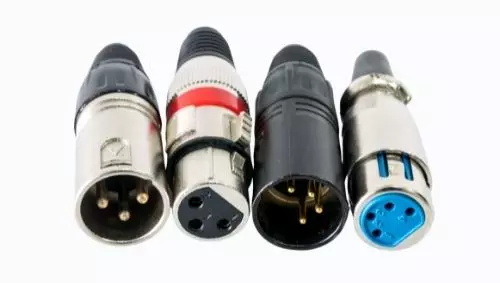
This connector is mainly used for balanced mono or stereo signals. It uses a male and female type of connection that provides three pins to connect the XLR cable plug into a receptacle. This format was developed by Canon Inc., which also designed it with rugged construction, allowing its use in open environments such as stages during live performances.
Common Usage: Professional Audio Equipment (Studio Monitors), Microphones, Lighting Systems, Stage Lighting Equipment.
RCA Connector (aka Phono)

The RCA connector is a type of electrical connector commonly used to carry audio and video signals. It was designed as a standard for connecting audio equipment to TVs, radios, VCRs, DVD players, etc.
Common Usage: Audio Equipment (Stereo Receivers), Video Distribution System.
S/PDIF Connector (aka TOSLINK)
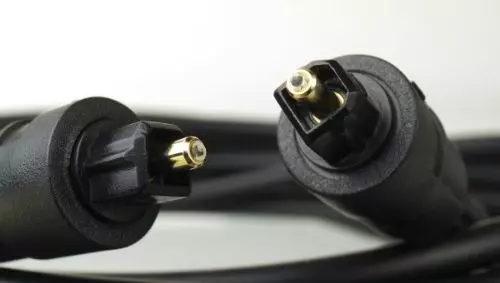
This type of connection is the most common digital solution for consumer-grade optical interconnections between components such as CD or DVD playback deck with an amplifier receiver for a sound system in home entertainment systems. In addition, S/PDIF uses fiber optic cables rather than coaxial cables like Toslink connectors which are more rugged and immune from interference problems that plague analog cabling with longer lengths.
Common Usage: Audio Equipment, Home Entertainment Systems, Computers.
Spade Lug Connector (aka Spades)
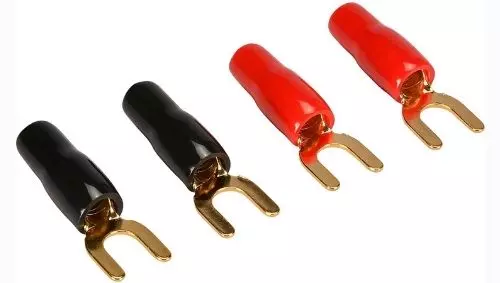
The spade lug is a connector that features two or three prongs designed to fasten the cable and connect it firmly with the electrical device for signal transfers. Again, different sizes are available depending on how they work best in your home audio system setup. The advantage here over most other wiring solutions is that you can solder them into place by clamping the stripped wire down onto one of these lugs before soldering both wires at once, so there's no need to strip extra lengths off each wire strand, which makes installation faster than traditional screw-type terminals found on larger speaker connectors.
Common Usage: Wiring Hardware (Speakers).
Banana Plug Connector (aka Banana Jacks)

This connector is often used to terminate speaker wires with amplifiers or speakers in home audio systems. The advantage here over most other wiring solutions is that you can solder them into place by clamping the stripped wire down onto one of these lugs before soldering both wires at once, so there's no need to strip extra lengths off each wire strand, which makes installation faster than traditional screw-type terminals found on larger speaker connectors.
Common Usage: Wiring Hardware Speakers, Audio Systems, PA System. Speaker Wire Terminals.
The clip connection features a U-shaped design and a positive locking mechanism, usually made from plastic.
It is often used for speaker wire connections to amplifiers or speakers in home audio systems and loudspeakers but can also be found on other types of wires, such as power cords. Common Usage: Wiring Hardware (Speaker Wire).
SpeakON Connector
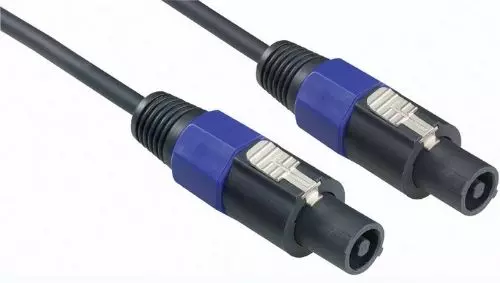
SpeakON connectors are considered a professional solution for electrical connections in PA systems, Sound Reinforcement Speakers, and Installer-Powered Loudspeaker Systems. SpeakON connectors are heavy-duty, high current electrical connections that can handle the power of up to 25 Amperes. In addition, they feature a twist and lock mechanism allowing for easy connection while also breaking away easily if tugged on accidentally, which makes them an excellent solution in live music performance environments where cables need to be connected quickly during setup changes between songs.
Common Usage: Wiring Hardware (Speaker Wire).
Analog & Digital Audio Connectors
Analog Cables:
- RCA (Phono) Connectors
- XLR & TRS Connectors for Live Sound
Digital Cables:
- Optical or Lightpipe Cable Types,
- S/PDIF
- AES/EBU Digital Audio Data Transmission Protocols
The majority of consumer audio devices use an analog connection to transmit valuable data through cables like these. However, there are two major types of digital cable connections that you should know about; they include optical and electrical connectors that can be used in professional applications. Each has its unique advantages depending on the specific situation at hand.
For example, some live sound mixing boards feature both options to accommodate various cases with ease.
Balanced vs. Unbalanced Audio Signals
An unbalanced signal is usually easier to transmit. It requires only one wire, while balanced signals require two or three wires. Unbalanced audio connectors are typically found on older equipment and have a greater chance of picking up noise from outside sources due to the lack of insulation surrounding them.
Balanced audio connectors are more common today due to their ability to reduce interference. An unbalanced signal is usually easier to transmit. It requires only one wire, while balanced signals require two or three wires. Unbalanced audio connectors are typically found on older equipment and have a greater chance of picking up noise from outside sources due to the lack of insulation surrounding them. Balanced cables are more common today due to their ability to reduce interference. They typically require three wires but can sometimes use two or four depending on the connections used.
If you are interested in learning more about Balanced and Unbalanced audio signals, Check out this article on Headphonesty.
Mono Vs. Stereo Signal
A stereo audio signal consists of two separate channels, while a mono signal is just one. The main difference between the two types is that they carry different information and thus require their own set of connections to be heard correctly.
Stereo cables consist of three wires: left, right, and ground. They are usually color-coded green for left and red for right; however, there can be some exceptions depending on manufacturer standards used or the region where the product was purchased from. This type typically requires an additional connection such as RCA jacks to transmit the sound accurately. A dual RCA cable will not work with this connector since it only has rings instead of both ring and tip like standard connectors do.
Conclusion
Audio cables come in various forms, some of which are more common than others. The most important thing to understand is what type you require and why before making a purchase. Knowing the difference between an unbalanced signal and a balanced one will help prevent noise interference from outside sources. Stereo connectors consist of three wires; however, they can sometimes use two or four depending on the type of connections used rather than just RCA jacks. Mono audio signals only have one channel compared to stereo ones with two for better sound quality and less interference.
Moreover, the most common type of connector is balanced audio cables which can reduce noise interference. Unbalanced signals are usually easier to transmit since they require only one wire but can pick up more outside interference resulting in low-quality sound or none depending on external sources. Stereo connections consist of left and correct wires with a ground wire for better sound quality than mono ones.
Finally, it is essential to know what you need before making any purchases so that there are no interruptions during playback or transmission down the road due to buying the wrong product! Although both types of signal wiring help improve sound clarity over long distances, they each come with their own set of pros and cons, as listed above, clearly detailing what makes them different from one another.
Related Posts
- Why You Should and Shouldn't Use Headphones for Workouts
- Hearing My Own Voice On Headset: What It Means & Why
- Do Headphones Cause Hearing Loss: Prevent & Treat
 |
 |
 |
 |
About Scarlett Martin
Scarlett Martin is an MSc Degree holder in Digital Audio Engineering. She has worked for well-reputed audio giants. In addition, she has been an audiophile all her life, making her a valuable addition to our staff. Her knowledge of headphones, audio, and other shoulder niches will help us and our audience.
Thoughts on "Types of Headphone Jacks & Plugs – Simplified and Explained"
 |
 |
 |
 |
Get FREE Headset Gifts now. Or latest free Music Guide from our best collections.
Disable Ad block to get all the secrets. Once done, hit any button below
 |
 |
 |
 |